Basic definition of give and go
Give and go is a tactic that occurs when one particular offensive player in possession of the basketball, typically near a perimeter area of the court, passes it to a second player, which is then followed up by a cut towards the basket from the first player, ultimately to receive the ball again for a possible scoring opportunity near the rim.
Examples of give and go action
This section contains different examples of give and go action that could lead to scoring opportunities, particularly layups near the basket.
It should also be mentioned that the offensive and defensive players on the subsequent diagrams do not have specified roles at this time and are simply denoted via numbers such as 1, 2, 3, X1, X2, etc.
Basic actions
This subsection includes basic actions of give and go that involves offensive players passing the ball from perimeter areas of the court followed by cutting to the basket.
Top to wing pass and cut

This basic action begins with 1 at the top with possession of the ball, represented by the black dot and 2 on the right side wing.
Afterwards, 2 receives the ball via a pass from 1, indicated by the dotted arrow. Next, 1 simply cuts straight to the basket, indicated by the solid arrow.
Following that, 1 could receive the ball from 2 and score by way of a close-range shot such as a layup, finger roll, or floater at the rim.
Wing to top pass and cut

For this basic action, 2 starts with possession of the ball and then passes it with 1 as the recipient.
From there, 2 cuts to the basket, receives the ball again from 1, and scores via a layup.
Wing to corner pass and cut

This basic action introduces a third player who fills the right side corner. To begin, 2 receives the ball from 1 and afterwards, 3 receives it from 2.
Next, 2 cuts to the basket, receives the ball again from 3, and scores points at the rim.
Corner to wing pass and cut
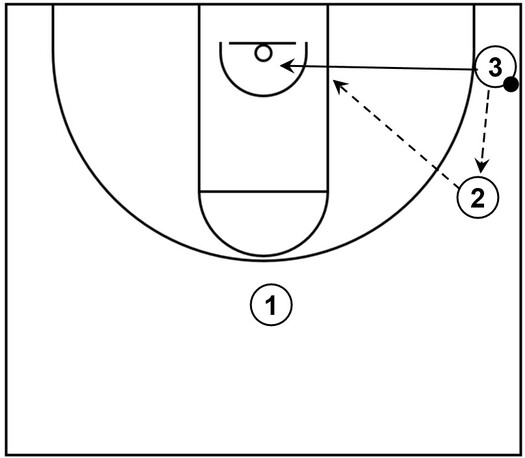
For this basic action, 3 starts with possession of the ball in the right side corner.
After that, 2 receives the ball from 3 who cuts straight to the basket.
Next, 3 receives the ball again from 2, and scores via a layup.
High post actions
This subsection comprises give and go actions that involve a high post player who receives the ball and gives it back to a player who goes towards the rim.
Handoff
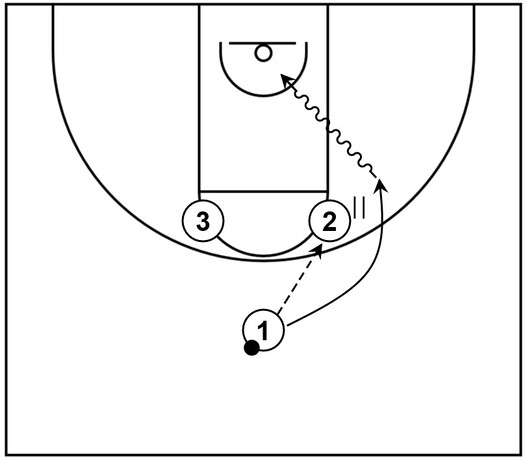
For this action, 1 begins at the top with possession of the ball while 2 and 3 occupy the high post elbow areas respectively.
Next, 1 has the option to pass to either 2 or 3. For this case, 2 receives the ball from 1. Afterwards, 1 cuts toward 2 on the outside, and receives the ball via a handoff, represented by the double pipe symbol.
Additionally, as soon as 1 has possession of the ball again, 1 immediately dribbles toward the lane, represented by the wavy arrow, to attack the rim and score via a layup.
Dive cut
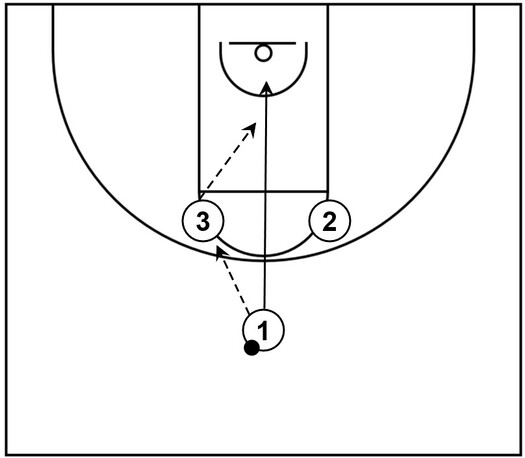
In reference to this example, this initial setup is similar to the previous diagram.
However, this time, 3 receives the ball from 1. Following that, 1 executes a dive cut straight down the middle, receives the ball from 3, and scores points via a close-range shot.
Backdoor cut 1
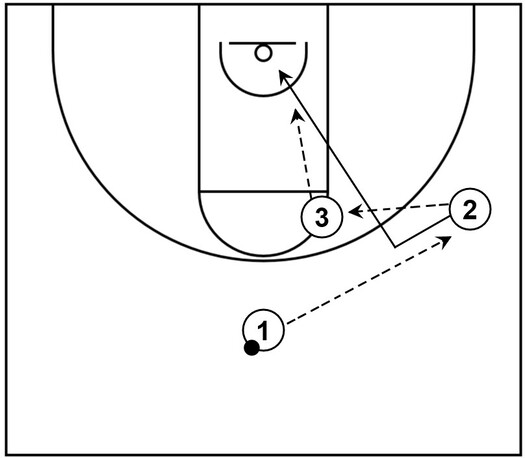
This is another example of high post action that begins with 1 at the top with possession of the basketball, 2 at the right side wing area, and 3 near the right side high post elbow.
To begin, 2 receives the ball from 1 and then 3 receives it from 2. Once that occurs, 2 performs a backdoor cut, receives the ball from 3, and scores at the rim.
Backdoor cut 2
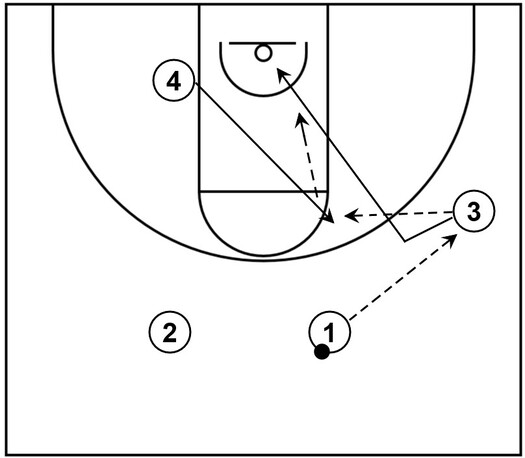
In relation to this example, the initial setup consists of 1 and 2 in the right and left slots, respectively. These are areas between the middle third or center of the top as well as the wing.
Additionally, 3 fills the right side wing while 4 occupies the left side low post area to start.
From there, 3 receives the ball from 1. Next, 4 performs a flash cut towards the right side high post elbow and receives the ball from 3.
Following that, 3 executes a backdoor cut towards the rim, receives the ball again from 4 and scores by way of a layup.
Backdoor cut 3
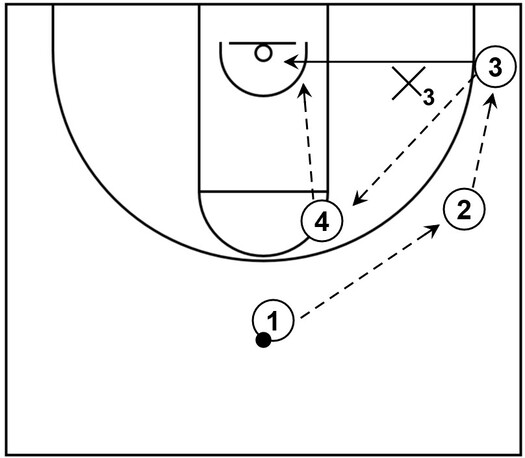
This is an example that is somewhat atypical for an actual game-like scenario. Nevertheless, it is shown here, mainly for demonstrative purposes.
To begin, 2 receives the ball from 1 and then passes it to 3 in the right side corner.
Next, 3 passes it to 4 and then cuts backdoor to the basket. Afterwards, 3 receives the ball again from 4 and scores at the rim.
This action may be effective to one degree or another if the corner defender, who is X3 on the diagram, were to turn their head to see the ball while losing sight of their assignment, that being the offensive player designated as 3.
Additional insights about give and go
General reference
It is generally referred to as give and go because as the name implies, an initial player will give the basketball to another secondary player.
Following that, the initial player will immediately go towards the basket, ultimately to score points after receiving the ball again from the second offensive player.
Potential benefits to consider
Practical method to develop offensive skills of passing and cutting
Give and go action could be a practical method of developing the fundamental skills of passing and cutting.
Passing is generally important because it promotes ball movement, which could also lead to defensive breakdowns.
Cutting is generally important because it promotes player movement and that could potentially lead to one or more mistakes by the opposing defense, which could also result in high percentage scoring opportunities.
Effective way to build chemistry between players and overall team
Give and go action could be an effective way to build chemistry between the two players involved in the primary passing and cutting activity as well as within the overall dynamics of the team altogether.
Basically, passing the basketball to teammates and receiving it from teammates builds trust while also promoting good teamwork alongside providing positive contributions to the team as a whole.